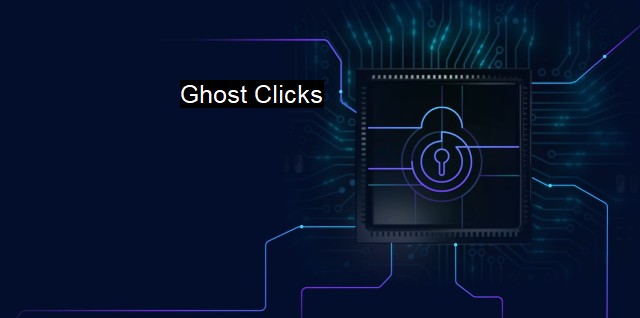What are Ghost Clicks?
Ghost Clicks: An Emerging Cybersecurity Threat to Online Advertising and User Data Privacy
Ghost clicks, often a welt of digital meat to cybersecurity experts, fundamentally belong to the domain of malicious online activities, deeply rooted in cyber threats aimed at undermining the safety and privacy of personal data. The concept derives its name from the invisible manner in which these malign acts are performed, likening them to paranormal activities we associate with "ghosts."a ghost click refers to automated or undetected clicks, often originating from malware or viruses, that aim to trick a system or a network into believing the interaction is by an actual user. These clicks can remotely control victim devices, coaxing them to perform actions the users did not authorize. It's the digital equivalent of a poltergeist, causing problems invisibly.
Notably, ghost clicks are part of broader cyber threats called click fraud, in which false clicks on online advertisements mislead advertisers to believe their advertisements are faring better than they actually are. This practice directly impacts businesses that rely on pay-per-click advertising for revenue by artificially inflating their digital advertising expenditures.
Click fraud can also harm users when fraudsters overlay ads on unauthorized websites, tricking users into either downloading malicious content or parting with their personal data. Advanced persistent bots can convincingly mimic human behavior, ensuring maximum click-generating capacity and stealth.
Another method that malicious agents employ for generating ghost clicks is installing clickjack malware within user devices that subsequently launch a string of ghost clicks. Cybercriminals often use this method to control user devices remotely for various purposes, such as bombarding both mobile and web platforms of a service with traffic to orchestrate a Distributed Denial of Service (DDoS) attack.
Ghost clicks pose significant challenges to antivirus software as these malicious activities give no clear signal for detection. Combating the issue requires regular scanning for suspicious activities, the use of third-party click activity monitoring systems, and furthering advancements in bot detection technology including by incorporating artificial intelligence.
The potentially autonomous nature of ghost clicks adds a further layer of complexity in formulating efficient protective methods. Overcoming this may require an advanced protective strategy with neural networks: layers of algorithms modeled loosely on the human brain, designed to recognize patterns aiming to discriminate between genuine and fraudulent activities.
Due to the seamless blending of these pseudo actions into the regular online pattern of activities, diagnosing the source of ghost clicks can be exceptionally challenging. given their subtle nature, they often escape the regular methods of detection in antivirus programs, proving problematic for Web service providers, advertisers, and consumers alike.
Ghost clicks have already demonstrated damage over the years. The infamous "DNSChanger malware" operation, which was dismantled by the FBI in 2011, infected more than four million computers across over 100 countries and allegedly netted the perpetrators $14 million.
In the age of booming online activity and surge in cyber threats, it is paramount to develop a nuanced understanding of ghost clicks and enhance mechanisms to protect against them. Ignoring this ghost in the machine may lead to consequential data breach, revenue loss and at worst – a tripwire to critical information. Rigorous protection and detection efforts backed by technology must be executed for battling the invisible yet insidious menace lurking around global cyberspace.
Ghost clicks are a telltale sign of the evolution of cybercrime; their threat is certainly not transparent. These invisible, scripted interactions are relentless in their efforts to infiltrate systems, cause interruptions, and inflict damage. The emerging challenge for cybersecurity, thus, lies not in denying their existence, but in facing them head-on with resourceful, innovative, and potent antivirus capabilities.

Ghost Clicks FAQs
What are ghost clicks in the context of cybersecurity?
Ghost clicks refer to fake or unauthorized clicks that occur without the user's knowledge or consent. These clicks are usually performed by malicious software or bots that infect a user's computer or device. Ghost clicks can lead to unauthorized access to sensitive information, installation of malware, and other cybersecurity threats.How can I detect if my computer has been affected by ghost clicks?
Some signs that your computer may have been affected by ghost clicks include an increase in pop-up ads or redirects to unknown websites, changes in browser settings, and a sudden decrease in system performance. It's important to regularly run antivirus scans and keep your software updated to prevent and detect ghost clicks.How can I protect my computer from ghost clicks?
To protect your computer from ghost clicks, you can install and regularly update a reputable antivirus software, avoid clicking on suspicious links or pop-ups, and be cautious when downloading or installing software from untrusted sources. Regularly backing up your files can also help mitigate the damage caused by a potential ghost click attack.What should I do if I suspect my computer has been affected by ghost clicks?
If you suspect your computer has been affected by ghost clicks, you should immediately run a full scan with your antivirus software and follow its recommended actions. You should also change all of your passwords for important accounts and monitor your accounts for any suspicious activity. If the problem persists, seek help from a professional IT specialist or cybersecurity expert.| | A | | | B | | | C | | | D | | | E | | | F | | | G | | | H | | | I | | | J | | | K | | | L | | | M | |
| | N | | | O | | | P | | | Q | | | R | | | S | | | T | | | U | | | V | | | W | | | X | | | Y | | | Z | |
| | 1 | | | 2 | | | 3 | | | 4 | | | 7 | | | 8 | | |||||||